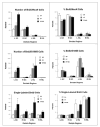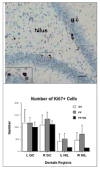Environmental enrichment increases progenitor cell survival in the dentate gyrus following lateral fluid percussion injury
- PMID: 16171896
- PMCID: PMC1553202
- DOI: 10.1016/j.molbrainres.2005.08.011
Environmental enrichment increases progenitor cell survival in the dentate gyrus following lateral fluid percussion injury
Abstract
Neurons in the hilus of the dentate gyrus are lost following a lateral fluid percussion injury. Environmental enrichment is known to increase neurogenesis in the dentate in intact rats, suggesting that it might also do so following fluid percussion injury, and potentially provide replacements for lost neurons. We report that 1 h of daily environmental enrichment for 3 weeks increased the number of progenitor cells in the dentate following fluid percussion injury, but only on the ipsilesional side. In the dentate granule cell layer, but not the hilus, most progenitors had a neuronal phenotype. The rate of on going cell proliferation was similar across groups. Collectively, these results suggest that the beneficial effects of environmental enrichment on behavioral recovery following FP injury are not attributable to neuronal replacement in the hilus but may be related to increased neurogenesis in the granule cell layer.
Figures






References
-
- Ambrogini P, Cuppini R, Cuppini C, Ciaroni S, Cecchini T, Ferri P, Sartini S, Del Grande P. Spatial learning affects immature granule cell survival in adult rat dentate gyrus. Neurosci Lett. 2000;286:21–4. - PubMed
-
- Arvidsson A, Collin T, Kirik D, Kokaia Z, Lindvall O. Neuronal replacement from endogenous precursors in the adult brain after stroke. Nat Med. 2002;8:963–70. - PubMed
-
- Baldwin SA, Scheff SW. Intermediate filament change in astrocytes following mild cortical contusion. Glia. 1996;16:266–75. - PubMed
-
- Bramlett HM, Dietrich WD. Quantitative structural changes in white and gray matter 1 year following traumatic brain injury in rats. Acta Neuropathol (Berl) 2002;103:607–14. - PubMed
-
- Briones TL, Suh E, Hattar H, Wadowska M. Dentate gyrus neurogenesis after cerebral ischemia and behavioral training. Biol Res Nurs. 2005;6:167–79. - PubMed
Publication types
MeSH terms
Substances
Grants and funding
LinkOut - more resources
Full Text Sources
Medical

